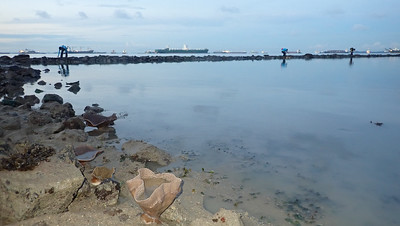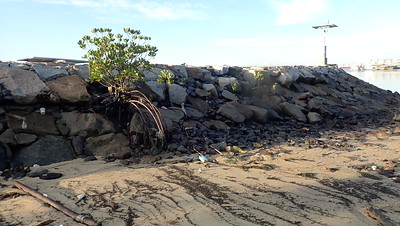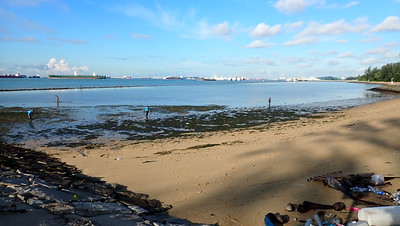This morning, a small team returned after 5 years, to check out the corals that settled on the 2.5km long seawall that is only exposed at super low spring tide.
I abandoned the team who bravely walked on the long slippery seawall. Check out their photos to see how the corals are doing there.
Here's a glimpse of the seawall thanks to Kok Sheng
Here's some awesome drone shots of this 2.5km seawall taken by Nathaniel Soon in May 2021.
I headed out to the seagrass meadows, mangroves and coastal forest that have natural settled here too. Seagrasses have done very well since our last survey in May 2016. With lush dense growths (no epiphytes) on large parts of the lagoon created between the long seawall and the reclaimed sandy shore. The most common seagrasses remains Spoon seagrasses (both small and large leaf blades) and Needle seagrass (both skinny and broad leaf blades).
On our last survey in May 2016, we only saw a small patch of Noodle seagrass. Today, there were large areas of this seagrass that we seldom see on our shores.On our last survey in May 2016, we only saw one small clump of Tape seagrass. Today, I saw at least 20 clumps, both on the low water mark and in deeper water in the middle of the lagoon. There was even one growing inside the canal (Kok Sheng took a photo of it as I was too fat and tired to negotiate the soft silt). All the clumps had nice long leaves, I didn't see any with cropped leaves. One had female flowers. I also came across two patches of healthy looking Serrated ribbon seagrass! We did not see this species on our last survey in May 2016.
The most abundant large animal in the seagrass areas were Haddon's carpet anemones. There were also various sea cucumbers, White sea urchins, living Thick-edged sand dollar, but I didn't see any sea stars. I came across a patch of Fan shell clams, most were dead though. Also abundant were Window pane shell clams, I also saw Hammer oysters. I saw an Onyx cowrie, a Naked moon snail, a large Snaky anemone and a Kanga nudibranch!
Mangroves have also settled naturally on the seawalls. The trees seem to be doing well. But I didn't see a lot more trees than we saw on our last survey in May 2016.
A lovely coastal forest has also settled naturally above the high water mark. I saw a good variety of plants adapted to the harsher conditions near the sea. How nice to walk along a shore planted by Mother Nature. With our very own wild trees and sea shore shrubs.
It was good to see the Bonduc is still there, although it was getting overgrown by other coastal plants. This rather bad-tempered plant with very poky branches is listed as 'Critically Endangered' in Singapore, with records of only three plants: in Pulau Semakau, Lazarus Island and Pulau Senang. The one in the East Coast is thus the fourth plant I know about.
While our recreational beaches are cleaned every day, restricted shores like this one is not. For an uncleaned shore, the amount of trash doesn't seem a lot: mostly floating plastic trash. Although I did come across a huge pile of plastic well behind the vegetation...not really sure how that happened.
This shore is one of the most recent that our team 'discovered'. Thanks to Arjun Sai Krishnan who shared with me some intriguing photos of corals at East Coast Park. As a result, Kok Sheng recced the area before a small team visited it for the first time in May 2015. We returned again in May 2016. But shortly after, the area became off limits and cameras installed to deter unauthorised entry. Today's survey is made possible by kind support of NParks who obtained permission from the relevant authorities. We are grateful.While our recreational beaches are cleaned every day, restricted shores like this one is not. For an uncleaned shore, the amount of trash doesn't seem a lot: mostly floating plastic trash. Although I did come across a huge pile of plastic well behind the vegetation...not really sure how that happened.
What is the future of these shores?
These living East Coast shores are precious because they may be reclaimed in the 2013 landuse plan by the Ministry of National Development released in response to 2013 Population White Paper.
The blue outlined areas are "Possible Future Reclamation". The plans include massive reclamation along the entire East Coast.
Natural regeneration on Singapore's artificial shores and structures is already happening now. Unintentionally, with zero replanting. Can we plan coastal works to allow reefs, mangroves and seagrasses to naturally regenerate? Naturalise canals leading to the sea for a continuum of freshwater wetlands to mangroves? Imagine what's possible! Reefs and natural marine ecosystems at our doorstep, for all in the City to enjoy. More about this idea in my feedback to the Draft Master Plan 2013.
Loh Kok Sheng
Richard Kuah
Vincent Choo















